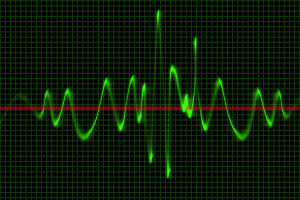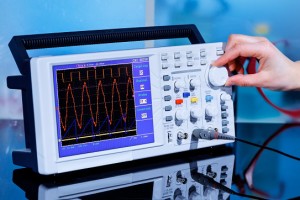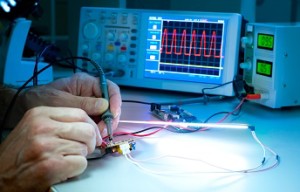 One of the essential pieces of equipment that a good electronics lab must be equipped with is an Oscilloscope. These machines are a mainstay for electronics engineers and technicians who are working with, designing, or troubleshooting high-speed electronics. Generally speaking, oscilloscopes allow the observation of signal voltages that are constantly in flux. As with many pieces of equipment, there are several different types, each possessing distinct functions and usage. For example, some of these scopes can convert non-electrical signals like sound or vibration into voltage in order to display fluctuations in the signals. Today, We’re going to look at the differences between several types of oscilloscopes.
One of the essential pieces of equipment that a good electronics lab must be equipped with is an Oscilloscope. These machines are a mainstay for electronics engineers and technicians who are working with, designing, or troubleshooting high-speed electronics. Generally speaking, oscilloscopes allow the observation of signal voltages that are constantly in flux. As with many pieces of equipment, there are several different types, each possessing distinct functions and usage. For example, some of these scopes can convert non-electrical signals like sound or vibration into voltage in order to display fluctuations in the signals. Today, We’re going to look at the differences between several types of oscilloscopes.
Analog Oscilloscopes
The first type of oscilloscope that we are going to look at today is an analog oscilloscope, which is relatively straightforward. A signal is detected by a probe and directly displayed on the screen. It has the capability to display waveforms for quite a time preventing them from decaying right away. As its name suggests, this equipment deals with transient effects and analog signals although it can effectively handle low digital signals as well. Analog oscilloscope tend to be more precise in their readings because they are immune to aliasing problems that can occur with digital oscilloscopes. Because of this, the equipment is most commonly used for precision troubleshooting applications.Digital Oscilloscopes
Digital oscilloscopes come in a variety of different types. They are notable for their excellent performance when working with both bandwidth and sampling rate.
Digital Storage Oscilloscopes
Many digital oscilloscopes are actually classified as digital storage oscilloscopes. These machines have the ability to record transient events and stock the data for later processing including printing, archiving, and analysis. The recorded data can also be transferred to other media devices for permanent storage and/or analysis. Generally, digital storage oscilloscopes do not display a signal’s level of intensity in real time. However, many of them are capable of analyzing four or more signals at the same time.
Digital Phosphor Oscilloscope
Another classification worth mentioning is the digital phosphor oscilloscope. Interestingly, this variety combines many of the benefits of analog oscilloscopes and digital storage oscilloscopes. They are used to capture and analyze high-speed digital signals that require higher sampling rates.
Mixed Domain Oscilloscopes
If you need to perform troubleshooting or other testing that requires time/signal correlation, you may want to consider the mixed domain oscilloscope. It combines a logic analyzer with an RF spectrum analyzer, allowing you to see signals in each domain.
Mixed Signal Oscilloscopes
This version combines the essence of the digital oscilloscope and with the logic analyzer. It can stimulate digital logic transitions while assisting analog events analysis.
Digital Sampling Oscilloscope
The last type of digital oscilloscope that we wanted to mention was the digital sampling oscilloscope. This version is noted for having a lower dynamic range and higher bandwidth.
Other Types of Oscilloscopes
Handheld oscilloscopes are small pieces of equipment that are essential for field testing applications. Nevertheless, with their small size, the sampling rate and bandwidth are limited.
Recently, computer-based oscilloscopes have also been emerging. They make use of external devices which are connected to a USB port of a computer. Among all the versions of oscilloscope, these generally offer the best sampling rates and increase of bandwidth.

